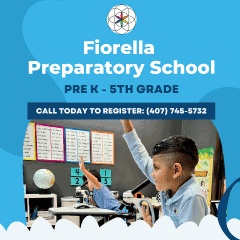Parenting Guide: Special Needs
Embracing the Individual
Every child with special needs is unique and it takes a personalized approach to provide the best possible care.

Raising a young child with special needs can present a unique set of challenges for many parents who find themselves trying to navigate unknown territory. Whether a child has emotional, behavioral or learning difficulties, special needs require special attention. No matter what a child’s diagnosis may be, it’s crucial to connect with them personally to increase their comfort level and help them unlock their full potential.
That personalized approach is vital because each child presents their own strengths and weaknesses; though they may share a particular diagnosis, their needs can vary and may need to be addressed in different ways.
Debra Beckman is the founder of Beckman and Associates, a specialty therapy clinic in Maitland that offers services to children who demonstrate a need for speech, occupational and physical therapy. She says a key first step is determining how to encourage a child and building from there.
“You have to find out what motivates them and make sure they have access to that so they feel comfortable,” says Beckman. “Their learning is going to be enhanced if their state is calm. Find where they’re comfortable and work with them where they are, you can always gradually modify. You want them to be happy.”
BrightStart Pediatrics is a Prescribed Pediatric Extended Care (PPEC) nursing and therapy center that specializes in skilled nursing as well as occupational, physical and speech therapy. It serves children who are dealing with diagnoses such as premature birth, Down syndrome, cerebral palsy, metabolic disorders, seizure disorders, brain disorders and chronic lung issues.
Julie Rosenzweig, an occupational therapist at BrightStart, says following the PPEC model and having these comprehensive services in one singular location allows its therapy team to better meet the needs of each child.
“All our children have specific needs based on their medical history, diagnoses and current medical status. Each discipline [of our therapy team] completes a comprehensive evaluation and develops a plan of care based on each individual child’s areas of concern. Personalized attention is crucial to facilitate each child to reach their therapy goals and have success. Since all therapies are under the same roof, we can work side-by-side to collaborate and work cohesively as a team,” says Rosenzweig.
Krista M. Marchman, Ph.D., founder and director of Educational Consulting Associates, specializes in psychological, psychoeducational and neurodevelopmental evaluations and interventions for children, adolescents, young adults and their families. With 35 years of experience in the field, she says it’s paramount that every evaluation she does takes an individual approach because there can be overlaps leading to a misdiagnosis.
“Attention-Defecit/Hyperactivity Disorder (ADHD), behavioral disorders, anxiety, depression, autism—all those things have overlapping similarities. Children coming from divorce or maybe bereaving a death could be experiencing anxiety, or maybe depression and sadness; they may have problems with attention, but it may not be ADHD as a diagnosis. You could have a child that presents with similar things, but it could be for different reasons,” she says.
“Everything I do comes from a neuropsychological evaluation standpoint,” Marchman continues. “I’m looking at data points that tell me why a child may be struggling, and all those data points have to be very individualized to that child. [Otherwise], that’s how we end up with misdiagnoses. If it looks like a duck, it doesn’t always mean it’s a duck.”
When children are faced with learning difficulties, no two experiences are identical, making one-size-fits-all educational strategies ineffective and potentially counterproductive to their academic growth.
Pace Brantley is a school in Longwood that specializes in teaching students with ADHD, obsessive-compulsive disorder, dyslexia, autism and other learning disabilities. Pam Tapley serves as its head of school and says the key lies in recognizing that each child brings a distinct constellation of strengths and challenges to the classroom.
“Rather than applying standardized interventions, educators must first understand where each student currently stands in their learning journey, then craft pathways to honor their individual pace and style of processing information,” she says.
That personalized approach helps transform education from a rigid system to a responsive partnership. With tailored instruction and meaningful connections being made, students are able to build upon small successes.
“It may seem small, but without those incremental successes, you can’t get to those bigger milestones,” says Melissa Lopez, director of Quest Kids Academy, a small Orlando private school that specializes in creating a supportive environment for children with developmental disabilities. “So as we celebrate these things and use lots of positive reinforcement, our kids get excited and they want to learn more.”
“The smallest milestones are huge for the children that I treat and we celebrate every success,” says Rosenzweig. “Developing rapport and a therapeutic relationship with each child is heartwarming and fills my professional cup on a daily basis. I love seeing their smiles and getting high fives with each new skill.”
Of course, incorporating families to be directly involved in the process is also critical. While children may be receiving expert care and guidance in a therapy session or in the classroom, making sure there is a carryover effect that enters into the home is equally important.
“If you don’t have the family members [involved], you’re not going to have a successful outcome” says Beckman. “I’ve had parents tell me, ‘Well, he usually does better if I’m not in the room.’ But in real life, you’re going to be in the room, and you’re the main team leader here.”
That is why Beckman makes sure parents are present with her whenever she’s conducting a therapy session so they can work as a team to see what works and what doesn’t.
“I want them to see those beginning steps and that if something doesn’t work, you can do this next. If that doesn’t work, you can do this. This way the caregiver can take that information and help it to grow in their home setting,” says Beckman.
Likewise, Rosenzweig says BrightStart is constantly working to involve families so children continue to reach new heights.
“As a therapy team, we encourage our families to come in and be part of their child’s therapy journey. Educating and enabling parents and caregivers to carry over therapeutic activities at home creates a holistic approach for each child to meet their goals,” she says.
Engaging families also provides useful information that parents can use moving forward, and Marchman says it gives them hope for what the possibilities are based upon what she’s found during an evaluation.
“I can direct them to the correct services and resources, and I’m very specific about that, and I prioritize that. For the parent, I am trying to answer all of those questions and point them in the right direction. And it’s so rewarding to me when a parent, for the first time, is starting to understand their child and feels as though they have steps [of an action plan] they can take.”
One of the biggest challenges in trying to connect with a special needs child is identifying where their aforementioned motivation lies, as it’s not always obvious. But understanding that motivation and being able to capture it and teach in a way that a student can make connections can have profound results.
“We draw from previous experience and things that we’ve seen and learned about to really comprehend life and the world around us. And our students don’t always have that explicit ability. So any time you can figure out how to make those little connections and draw from their motivation, you can really tap into their inner potential,” says Lopez.
Having that deeper understanding allows children to be supported not only academically but also socially as they form critical life skills with a foundational ripple effect beyond the classroom.
“When children receive instruction tailored to their learning differences, they develop confidence, self-advocacy skills and resilience that serves them well into adulthood,” says Tapley. “They learn not just academic content, but how to navigate a world that may not always accommodate their unique ways of thinking and learning.”
That’s not to say there aren’t significant obstacles that present themselves along the way. Many special needs children harbor feelings of low self-esteem and that they are unable to succeed. After years of struggles, they can form what educators refer to as “learned helplessness.” Changing that mindset from “I can’t” to “I can’t yet” takes constant reinforcement, persistence and the appropriate support systems in place.
Over time, students who once avoided challenges begin to embrace them. They develop the courage to ask questions, seek help when needed and learn to become their own advocates.
“The transformation can be remarkable to observe,” says Tapley.
Building upon that confidence with special needs children transitioning into less-restrictive environments is one of the most rewarding aspects of working alongside them, says Lopez.
“Becoming more independent looks different for every child, but that’s our goal over time,” she says. “We don’t want them to need us forever. So if we’ve achieved that goal and we can let go and they can do more on their own, then we’ve done our job.”
Ultimately, meeting special needs children where they are is making an investment in their future. By ensuring their child is receiving the personalized attention they require, parents will feel empowered to keep their child’s successes growing.











